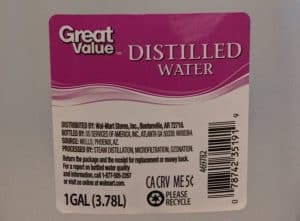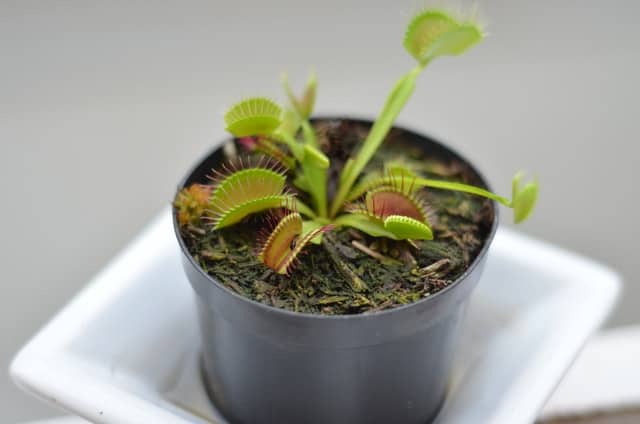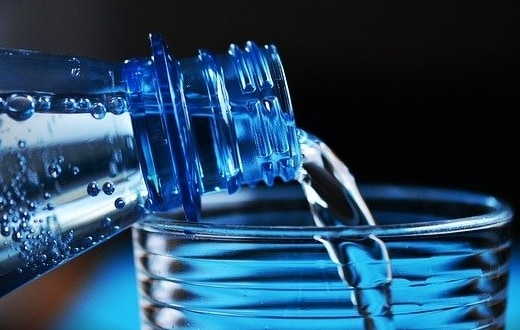Venus fly traps have particular requirements, including a specific water type. Buying bottled water for Venus flytraps can be safe, but it depends on the specific type and composition.
Standard bottled water can kill Venus flytraps as it contains minerals and other additives. Pure bottled distilled water or reverse osmosis water are suitable water sources. Besides the bottled options, clean rainwater is also safe for Venus flytraps.
In this article, you will learn exactly which water to use for your Venus flytrap. Choosing the wrong water can burn your plants, so it is crucial information for all carnivorous plant owners.
Can Venus Fly Traps Drink Bottled Water?
In the wild, Venus flytraps live in inferior soils with little to no access to minerals or nutrients. As a result, Venus flytraps have developed an intolerance to minerals.
When choosing the soil and water for Venus flytraps, always employ pure nutrient-free, mineral-free components. Water with minerals can cause mineral burns to the plant and eventually kill it.
Bottled water is unsuitable for Venus flytraps. Standard bottled water (such as Smartwater, Dasani) is made for human consumption. And, that water is enriched with minerals for taste, which can be harmful to Venus flytraps.
Do not employ standard bottled water for Venus flytraps unless you have confirmed it is pure. The next section will give you the details about which water you need to buy (or collect), and where you can get it.
What Kind of Water Do I Give My Venus Fly Trap?
Employing the right type of water for Venus flytraps is critical but not complicated.
Venus flytraps should be only be watered with distilled water, reverse osmosis water, or rainwater. The water must be pure as Venus flytraps are intolerant to minerals. Avoid tap water or bottled water at all costs.
- Distilled water: Distilled water is an inexpensive option. You can buy a gallon of pure distilled water in most supermarkets for a dollar or less. Also, water and ice stores sell one gallon of distilled water for 25 cents.
- Rainwater: This option is completely free if you have a system in place. Some people collect rainwater in their homes and use them to water their plants. If you employ rainwater for Venus flytraps, make sure the water is still pure. Dust is fine, but if you collect rainwater through a piping system in your roof and that roof is made of metal, then that water might be unsuitable for Venus flytraps.
- Reverse osmosis water: Reverse osmosis water is sometimes available in supermarkets. Water and ice stores also sell reverse osmosis water for a reasonable fare (50 cents – 1 dollar a gallon).

You can employ distilled water, reverse osmosis water, or rainwater for Venus flytraps. Non is better than the others; all are pure water sources suitable for carnivorous plants.
Is Filtered Water Safe for Venus Flytraps?
You could take standard bottled water or tap water and filter it. The filters might get rid of impurities but won’t be able to extract chemicals in the water. A standard Britta filter, for example, can’t extract those elements or minerals.
Filtered tap water or bottled water is harmful to Venus flytraps. Standard filters do not remove minerals and other chemicals from the water.
It is also possible to filter distilled water, reverse osmosis water, or rainwater, but it not necessary. You won’t be providing any extra benefit by going through the extra step.
For more information on how to water Venus flytraps, watch this video:
How to Save a Venus Flytrap Watered With the Wrong Water?
When growing carnivorous plants, it is common to make mistakes. Do not be overly worried after watering your plant with the incorrect water source, but make sure to correct your mistake as soon as possible.
When Venus flytraps receive water with minerals, such as tap water or bottled water, the plant might exhibit different harmful effects. Usually, the plant exhibits minerals burn, which is characterized by an increase in yellow leaves.
The amount of harm depends on how long you have employed the wrong water source and how many minerals are retained in the soil.
Depending on the state of your plant, you can save it through different methods. First, assess the damage and follow the steps for your respective scenario.
- Mild damage: The Venus flytraps were watered with the incorrect water source, but it does not exhibit any major changes.
- Medium damage: Some leaves within the plant exhibit mineral burn, and some others might be dying. Still, there are at least a couple of healthy leaves.
- Serious damage: The majority of the leaves are dying, and the plant looks weak.
Depending on the state of your plant, follow the respective solution.
Save a Plant with Mild Water Damage
Since your plant has not been greatly affected by the watering, there is no need to make any major changes. This is what you have to do:
- Stop using the incorrect water source.
- Drain any existing water from your plant’s water tray and drain as much water from the soil as you can.
- Buy the correct water: distilled water or reverse osmosis water.
- Water your plant several times and allow the water to drain through the drainage holes. The water flow will help clear the soil from excess minerals.
- Continue to water the plant with the correct water source.

Save a Plant with Medium Mineral-burn Damage
If your plant falls in this category, it is just in the middle. Your Venus flytrap might start recovering or get worst in the coming days. Here is what you need to do.
- Stop using the incorrect water source right away
- Drain any water from your plant’s water tray and let it drain for a few minutes to extract the water.
- Obtain the correct water: distilled water or reverse osmosis water.
- Water your Venus flytrap with the correct water and let it drain. Repeat a few times to rinse the soil.
- Wait a few days while you continue to water your Venus flytrap appropriately.
If the plant gets better, continue caring for it, but do not make any major changes. If your plant continues to look down and more leaves start withering, then it is time for a more aggressive approach.
Follow the instructions in the section below and repot your plant in fresh soil. This article can guide you with the process if you are unfamiliar with the potting and repotting steps. It contains pictures and detailed instructions.
Save a Plant with Serious Mineral-burn Damage
To save Venus flytraps suffering from serious mineral burns, you must act quickly. The overall goal is to transition the plant to a clean medium and care for it properly to promote new growth.
Follow these instructions to recover your plant:
- Buy new carnivorous plant soil.
- Remove your plant from its current potting medium. When the soil is loaded with minerals, the plant can continue to debilitate. In those cases, repotting is a good alternative.
- Pot your plant in fresh soil. When moistening the soil, make sure you only use rainwater, distilled water, or reverse osmosis water.
- Continue to water your Venus flytrap only with the correct sources.
- During the upcoming weeks, focus on providing optimal care. Your plant is weak; you need to encourage the growth of new leaves to save it. This guide can help you improve your plant’s setup and promote growth: 11 Tips to Grow Big Venus Flytraps.
Additional Watering Considerations
Killing a Venus flytrap or any of your plants can be extremely disappointing. I hope this guide helped you pick the right water for your plant and keep it healthy. Bottled water might seem harmless for humans and most plants, but for Venus flytraps, it can be a silent killer.
Choosing the correct elements to grow your Venus flytraps is the first step to success. In regards to watering, there are many related considerations besides the water source, such as:
- Watering frequency
- Watering during dormancy
- Watering in low humidity environments
- Etc…
You can learn more about the watering process. Read this article => Venus Flytrap Watering Procedure: Sources, Frequency, and Tips. The article will make sure you master the watering technique. It is targeted towards Venus flytraps, but most tips apply to carnivorous plants in general.


